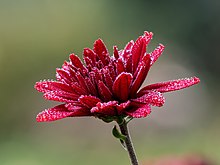Dew
This article needs additional citations for verification. (October 2015) |






Dew is
As the exposed surface cools by radiating its heat, atmospheric moisture condenses at a rate greater than that at which it can evaporate, resulting in the formation of water droplets.[2]
When temperatures are low enough, dew takes the form of ice, called frost.
Because dew is related to the temperature of surfaces, in late summer it forms most easily on surfaces that are not warmed by conducted heat from deep ground, such as grass, leaves, railings, car roofs, and bridges.
Formation
Water vapor will condense into droplets depending on the temperature. The
Occurrence
Adequate cooling of the surface typically takes place when it loses more energy by
The processes of dew formation do not restrict its occurrence to the night and the outdoors. They are also working when eyeglasses get steamy in a warm, wet room or in industrial processes. However, the term condensation is preferred in these cases.
Measurement
A classical device for dew measurement is the drosometer. A small (artificial) condenser surface is suspended from an arm attached to a pointer or a pen that records the weight changes of the condenser on a drum. Besides being very wind sensitive, however, this, like all artificial surface devices, only provides a measure of the meteorological potential for dew formation. The actual amount of dew in a specific place is strongly dependent on surface properties. For its measurement, plants, leaves, or whole soil columns are placed on a balance with their surface at the same height and in the same surroundings as would occur naturally, thus providing a small lysimeter. Further methods include estimation by means of comparing the droplets to standardized photographs or volumetric measurement of the amount of water wiped from the surface. Some of these methods include guttation, while others only measure dewfall and/or distillation.
Significance
Due to its dependence on
Another effect of dew is its hydration of fungal substrates and the mycelia of species such as pleated inkcaps, often found on lawns, and Phytophthora infestans which causes blight on potato plants.[6]
Historic
The book
In Greek mythology, Ersa is the goddess and personification of dew. Also, according to the myth, the dew in the morning was created when
Dew, known in
In the Biblical Torah or Old Testament, dew is used symbolically in Deuteronomy 32:2: "My doctrine shall drop as the rain, my speech shall distill as the dew, as the small rain upon the tender herb, and as the showers upon the grass."[11]
In the Catholic Mass in the Western Rite, whenever the Second Eucharistic Prayer is used, the priest prays over bread and wine, to God the Father; ‘Make holy, therefore, these gifts, we pray, by sending down your Spirit upon them like the dewfall, so that they may become for us the Body and Blood of our Lord Jesus Christ.’ The idea that the Holy Spirit enters the world and our lives in a quiet, undramatic way, ‘like the dewfall’, has great appeal for many Christians.
Artificial harvesting
The
Large-scale dew harvesting systems have been made by the
A large-scale dew harvesting scheme envisages circulating cold sea water in EPDM collectors near the seashore. These condense dew and fog to supply clean drinking water.[13] Other, more recent, studies display possible roof integration for dew harvesting devices.[14]
References
- ^ "dew". Merriam-Webster.com Dictionary.
- The Columbia Encyclopedia(6th ed.). Retrieved 18 May 2013.
- ^ a b "Dew and Frost Development". ZHU Training Page. National Weather Service, NOAA. Retrieved 2021-10-21.
- hdl:10125/8818/.
- S2CID 18134058.
- ^ "Late Blight in Potato — Publications". www.ag.ndsu.edu. 5 May 2017. Retrieved 2021-10-21.
- ^ Aristotle; Forster, E. S.; Dobson, J. F. (1914). De Mundo. p. End of chapter 3.
- Jewish Encyclopedia. Retrieved 21 Dec 2008.
- ISBN 978-0-19-861060-1. Retrieved 2018-11-17.
- ^ "Abital". Retrieved 2013-06-27.
- ^ Deuteronomy 32: King James Version, accessed 22 September 2019
- ISSN 0022-1694.
- .
- .
External links
- OPUR (International Organisation for Dew Utilization)
- International Conference on Fog, Fog Collection and Dew
- Audio Recording of Cantor Yossele Rosenblatt's Dew Service from the Florida Atlantic University Judaica Sound Archives (Hebrew audio)
